Papers by Lisa M Feldstein
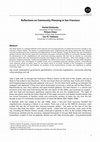
This paper builds on a dialogue between barrio planners and municipal planners on spatial and eco... more This paper builds on a dialogue between barrio planners and municipal planners on spatial and economic changes in San Francisco’s Mission District. The Mission is a predominantly Latino neighborhood with vibrant streets that have reflected and been transformed by the investments and displacement of recent decades. Though the Mission has seen tremendous upheaval with the influx of new capital and communities, this paper contends that efforts of community members shaped the development of the neighborhood with street-level planning expertise. We find that an attempt by community members to define their own development proposals and engage in land use decisions– rather than waiting to react to developer-designed proposals– created new possibilities for cultural and economic resiliency. Through skillful navigation of the economic crisis, convergence of multiple voices, and a sustainable grassroots planning process, community-led urban planning carved out public space for non-expert voic...
Justice Spatiale/Spatial Justice
Maine Law Review, 2013
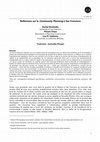
This paper builds on a dialogue between barrio planners and municipal planners on spatial and eco... more This paper builds on a dialogue between barrio planners and municipal planners on spatial and economic changes in San Francisco’s Mission District. The Mission is a predominantly Latino neighborhood with vibrant streets that have reflected and been transformed by the investments and displacement of recent decades. Though the Mission has seen tremendous upheaval with the influx of new capital and communities, this paper contends that efforts of community members shaped the development of the neighborhood with street-level planning expertise. We find that an attempt by community members to define their own development proposals and engage in land use decisions– rather than waiting to react to developer-designed proposals– created new possibilities for cultural and economic resiliency. Through skillful navigation of the economic crisis, convergence of multiple voices, and a sustainable grassroots planning process, community-led urban planning carved out public space for non-expert voic...

Book Review: Food and the City: Histories of Culture and CultivationImbertDorothée ed. 2015. Food and the City: Histories of Culture and Cultivation. Washington, DC: Dumbarton Oaks. 376 pp. $55.00 (hardback). ISBN 978-0-88402-404-0
Journal of planning education and research, Jun 13, 2016
fact, asserts that “planning theory is . . . pretty much silent on [leadership] . . . it is almos... more fact, asserts that “planning theory is . . . pretty much silent on [leadership] . . . it is almost as if leadership is an intellectual no-go zone” (208). Proponents of communicative planning might argue otherwise—that planners act as leaders when forming consensus. Hambleton, however, would reply that such a coordinating activity is insufficient, that real leadership requires vision and the ability to mobilize backing. The innovation stories range from the case of communitybased leadership to create New York’s High Line Park to Ahmedabad’s university engagement with the city to Auckland’s development of metropolitan governance under the guidance of an elected mayor. Several narratives relate the promotion of sustainability without exclusivity. He illustrates this with a discussion of Freiburg’s collaborative approach, involving political officials, the director of planning, and community activists to create an eco-city. Based on the Freiburg experience, he highlights the role of senior politicians and their appointed chief officers in establishing a vision for the city that incorporates a moral stance about equity and the environment. Their vision then sets a tone that spurs others to activism on behalf of inclusiveness and environmental protection. Hambleton intelligently debunks a number of the fashionable approaches to urban policy that have prevailed over the last couple of decades. He criticizes the ideal of “the new public management,” (NPM) which espouses importing private management techniques into the public sector and using marketdriven behaviors for the delivery and consumption of public services. He considers that NPM damages the ethos of public service and contributes to inequality. He regards the “smart cities” approach as a misguided technological fix to problems that run deep. He remarks that it is a vague term which acts as a rhetorical device, implying that disbelievers must be in favor of ignorance. He sees the reliance on information and communications technology (ICT) as furthering the digital divide between the well-educated and poor communities and finds no evidence to support the frequently made contention that use of ICT and big data enhances democracy. He contrasts being smart with being wise and contends that judgment, not data manipulation, constitutes the key to civic leadership. He regards resilience as yet another rubric characterized by vagueness—one more empty signifier to connote virtue without giving it a specific meaning and acting as a smokescreen for policies that do not take into account distributional effects. He saves his really heavy artillery for an attack on “best practice” as a guide for policymakers. Even though his book is a plea for cross-national learning, he strongly opposes simple imitation on the following grounds: it is based on hindsight rather than foresight; it is neglectful of context that may make a policy work in one place but not another; it may find “success” in a way that denies underlying conflict and overlooks negative distributional consequences. He contrasts the notion of best practice, which implies a right answer to a policy question, to a knowledge utilization perspective that draws lessons from the experience of other places without replication. Despite its virtues, the book has some weaknesses. It fails to deal with how innovations can be brought to scale—do they lead only to what Castells once dismissed as merely a municipal revolution or can they, when linked together, provide the basis for system transformation? The innovation stories tend to be very short and somewhat uncritical, a point that Hambleton raises about best practice prescriptions but which might equally apply to his accounts. For example, New York’s High Line did represent a triumph of community activism, but the community leadership involved was drawn from the professional classes and, although the park serves as an economic driver and is itself not exclusionary, it has stimulated rapid gentrification of its surroundings. The recounting of Mamamatsu, Japan’s willingness to incorporate non-Japanese nationals refers to assimilation of foreigners of Japanese descent, who still only amount to 3.1 percent of the population. This hardly represents a significant move to multiculturalism. In Toronto, where more than half the population is foreign-born, the election of a right-wing mayor Rob Ford in 2010 led to a reversal of the previous direction. Ford has now been deposed, but the fact he was elected in the first place points to the difficulty of institutionalizing inclusiveness. In his attempt at instilling optimism, Hambleton evades confronting the frailty of progressive reform and the likelihood of blowback. Nor does he deal with the tenacity of capitalism in co-opting or defeating initially progressive regimes. He glosses over some of the really serious underlying divisions that characterize the places he chronicles. Thus, although he mentions the extreme ethnic hostility…
Land Use Laws and Access to Tobacco, Alcohol, and Fast Food
Policy and Legislation for Healthy Places
Making Healthy Places, 2011
Land Use Laws and Access to Tobacco, Alcohol, and Fast Food
The Journal of Law, Medicine & Ethics, 2007
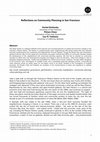
Justice Spatiale/Spatial Justice
Cet article analyse le dialogue qui s'est instauré entre les aménageurs issus du barrio et les ur... more Cet article analyse le dialogue qui s'est instauré entre les aménageurs issus du barrio et les urbanistes de la municipalité, à propos des transformations spatiales et économiques du quartier de la Mission à San Francisco. La Mission est un quartier majoritairement hispanique, dont les rues animées sont à la fois le reflet et le produit des processus d'investissement du capital et de déplacement de la population de ces dernières décennies. Alors qu'il a connu des bouleversements considérables liés à un afflux inédit de capital et de populations, cet article montre que les habitants de la communauté ont réussi à peser sur l'évolution du quartier, grâce à leur expertise d'habitants dans le domaine de l'aménagement. Il analyse la manière dont les membres de la communauté tentent de définir leurs propres propositions d'aménagement et de participer aux décisions portant sur l'usage des sols -plutôt que d'attendre les propositions conçues par les promoteurs -créant ainsi de nouvelles possibilités de résilience culturelle et économique. En naviguant habilement entre les contraintes de la crise économique, la divergence de points de vue des acteurs et les principes d'aménagement durable par le bas, ce processus d'aménagement conduit par la communauté a créé un espace inédit pour que la voix de ceux qui ne sont pas des professionnels de l'aménagement puisse être entendue. Au carrefour de ces différents processus, le People's Plan et le Pueblote illustrent la manière dont les plans et régulations d'aménagement peuvent répondre aux besoins de la communauté.
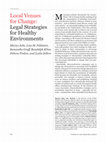
Journal of Law Medicine & Ethics, 2007
Mounting evidence documents the extraordinary toll on human health resulting from the consumption... more Mounting evidence documents the extraordinary toll on human health resulting from the consumption of unhealthy food products and physical inactivity. In response to America's growing obesity problem, local policymakers have been looking for legal strategies that can be adopted in their communities to encourage healthful behaviors. In order to provide practical tools to policymakers, this article examines four possible venues for local policy change to improve the health of a community: (1)the school environment (2)the built environment () community facilities and (4)the point of sale environment. Finally, the article examines the use of taxes or fees as a means of paying for nutrition policy work as well as potentially reducing the consumption of unhealthy products. This article illustrates that local laws and policies can be a valuable tool in changing a community's environment in order to improve nutritional options and increase opportunities for physical activity.
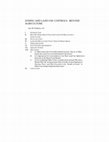
Maine Law Review, Jun 2013
Abstract: Retail food venue locations are considered expressions of rational market forces. Food ... more Abstract: Retail food venue locations are considered expressions of rational market forces. Food access is rarely justification for government intervention in markets through zoning controls. Indeed, connections between zoning and food are infrequently considered beyond agriculture, yet zoning affects urban food availability. Some jurisdictions have recognized that zoning is not value-neutral and have exercised zoning authority to influence food environments.
This paper interrogates the relationship between urban food access and zoning. Using examples of fast food and grocery zoning, questions considered are: (1) Whether/how form determines function (zoning determines food access); (2) The appropriateness of government exercise of zoning authority to intervene in retail food markets; and (3) Is government intervention in food access justifiable as necessary market regulation, as for housing and water? The author does not attempt to “solve” these questions, but rather considers them within the context of rapidly evolving understandings of food and society.
Select Publications by Lisa M Feldstein
Justice Spatiale / Spatial Justice, Dec 2013
By Rachel Brahinsky, Miriam Chion, and Lisa M. Feldstein







Uploads
Papers by Lisa M Feldstein
This paper interrogates the relationship between urban food access and zoning. Using examples of fast food and grocery zoning, questions considered are: (1) Whether/how form determines function (zoning determines food access); (2) The appropriateness of government exercise of zoning authority to intervene in retail food markets; and (3) Is government intervention in food access justifiable as necessary market regulation, as for housing and water? The author does not attempt to “solve” these questions, but rather considers them within the context of rapidly evolving understandings of food and society.
Select Publications by Lisa M Feldstein
This paper interrogates the relationship between urban food access and zoning. Using examples of fast food and grocery zoning, questions considered are: (1) Whether/how form determines function (zoning determines food access); (2) The appropriateness of government exercise of zoning authority to intervene in retail food markets; and (3) Is government intervention in food access justifiable as necessary market regulation, as for housing and water? The author does not attempt to “solve” these questions, but rather considers them within the context of rapidly evolving understandings of food and society.